Tree Identification:
Key Features for Identifying Trees
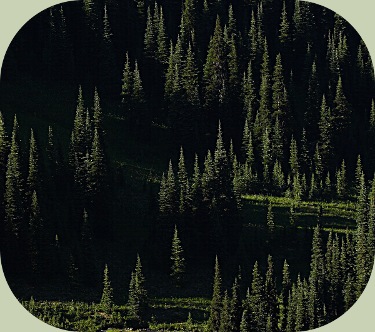
Do you need help with tree identification?
Imagine you are walking in your local park on a beautifully sunny summer afternoon. Your path leads you through the grass to an old, mossy tree with many branches reaching at angles into the sky above. Large, broad leaves create a deep shade and a filtered green light below. You look at this magnificent natural sculpture and ask yourself, what kind of tree is this? How do you get started with learning tree identification? It can seem like such an overwhelming prospect, with over 100,000 species on the planet!
Tree identification is most easily done if you look at the parts of a tree in front of you, and using them, look up the tree in a field guide or reference book. Identifying trees is a vital skill to know for wilderness survival, as trees provide a great deal of assistance when for instance, making shelters, fires, tools and even potentially clothing. Trees were held in great respect around the world by indigenous peoples and continue to be important to many for all the gifts that they provide.You can break down tree identification most easily into its physical parts: leaf, flower, fruit/cone/seed, branch type, bark, and crown form.
Leaf
Let us start with the leaf as we focus on tree identification. The leaves of trees vary widely from one species to another. Ask yourself the following questions:
- Is the leaf needle-like, scale-like or broad/flat leaves?
- If needle-like, does it grow singly, in bundles of 2, 3, 4, or 5?
- If scale-like, are the scales small and flattened or spiky? Are the large and triangular?
- If broad leaves, what shape are they? Long and pointed? Rounded and circular?
- Are they a simple or compound leaf (another wards, do they form smaller leaflets)?
- If simple, do the leaves show symmetry or asymmetry?
- Is the leaf lobed in a palmate (like the fingers on a hand) or pinnate (lobes originate from several places along the main vein) fashion?
- Are the lobes pointed or rounded?
- Is the leaf edge smooth? Is it wavy? Does it have sharp, pointed teeth? Does it have double teeth (2 teeth between each vein as it reaches the edge of the leaf)? Does it have rounded teeth?
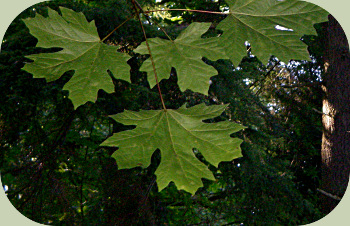
Leaves can tell you a great deal about a tree including what family it belongs to, how it is adapted to where it is native, what species it is and more things that help with tree identification. But sometimes using the leaves alone is not enough to help you with identifying trees. The next part to look at to help you out is the flower.
Flower
Many trees only flower at a particular time during the year and therefore, using flowers for identification can be more challenging. Even still, looking at the flowers when they are available can be tremendously helpful. Here are some details for you to look at and think about when you see them:
- Does the flower have petals?
- If so, how many petals per flower?
- What color(s) is the flower?
- On what part of the tree is the flower showing up on?
- Are the flowers found singly or in clusters?
- What do the clusters look like?
Be More Prepared For Your Next Outdoor Adventure!

Don't leave home without knowing these six essential survival skills. Our free survival mini guide reveals the strategies of:
- Shelter & fire to prevent the number one cause of death
- Obtaining clean water to avoid life-threatening dehydration
- Common wild survival foods and other critical skills!

Fruit
After you have checked the tree for flowers, take a look around for the fruit or nut. Some trees will have a period of overlap when flowers and fruits will appear on the trees at the same time, but generally this is only temporary. Fruits and nuts can be major features in tree identification for certain species. Here are some things for you to look for when practicing tree identification:
- What shape is the fruit? For example like a plum, or a cherry, or a blackberry?
- What color/texture is it?
- How big is the fruit?
- Is the fruit like a berry, a plum or peach?
- Is it more like a winged seed?
- If you don’t see fruit, do you see any nuts on the tree?
- What shape and color are the nuts?
- How large are they?
- Are the nuts covered in hard smooth, spiny or shaggy husks?
Some trees produce fruits that do not resemble anything you might pick up at a fruit stand or grocery store. For instance, some trees produce seed pods not unlike peas. Others might have fruits that are just a big cluster of seeds stuck together in a string or a sphere shape. Next let’s take a look at the bigger picture.
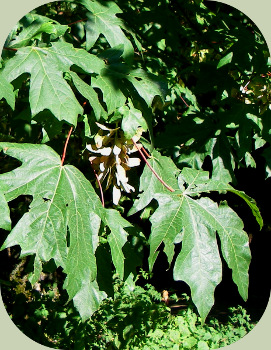
Branches
When you look at the branches of a tree, you can tell a lot about its life and use them in tree identification, especially in the wintertime. Desert trees tend to have short, gnarled branches while trees in moisture areas have longer, more tapered branches in general. There are several things to keep an eye out for while noticing the branches of a tree:
- Do the branches grow in straight patterns, or in zigzags?
- At what angle do the branches grow out from the trunk of the tree?
- As they grow, do the branches divide in an alternating pattern (alternate) or coming out in opposing pairs (opposite)?
- Is the bark on the branches smooth, flaky or rough?
Bark
Next, look at an even larger part of the tree: the bark of the main parts of the tree. Look at the bark, its texture and whether or not something is growing on the bark. Here are some things to keep an eye out for:
- Is the bark smooth or bumpy?
- Is the bark thick or thin?
- Is it shaggy, scaly, flaky, cracked, grooved, plated, fissured, deeply creased, or fibrous?
- Do the patterns in the bark run across the tree or up and down the trunk?
- Is the bark a single color, or multiple colors?
Crown Form
Finally, it can help you to look at the trees overall shape and color.
- Is it tall, straight and column-like as in a redwood tree?
- Is it squat, spreading and sprawling like a live oak?
- Is it contorted and twisted in form like a bonsai tree
- Does it have multiple trunks or a single trunk?
- If a single trunk, does it continue as a single trunk to the top or does it split into multiple trunks part way up?
Putting it all Together
So now that you have some tools to help you practice tree identification, let’s go back to our initial encounter with the mossy tree we met earlier. Let us run through the details and see what we get, starting with the leaves.
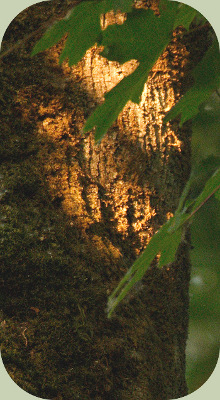
Leaves: you notice the leaves are large, broad, with 5 lobes and deep indentations and a long stem that attaches them to the branch
Flowers: Looking around, you don’t see any flowers. You remember that it is late summer and most trees in this region flower in spring.
Fruit: Though you don’t see any typical, edible looking fruit you do see these winged seeds. They hang in paired clusters near the branch tips.
Branches: They show a characteristic pattern of branching in opposites.
Bark: Most of this beautiful tree is covered in a thick, varied blanket of moss. Though it is hard to see the actual bark of the tree on most of the trunk, you see a spot light up by a spot of sunlight. The trunk is grayish, with long, vertical ridges of raised bark and appears thicker where the tree divides into multiple trunks.
Crown Form: The overall form of the tree is immense, column-like, starting at ground level with a single mossy trunk. As your eyes move upward you can see the trunk divide into 2 main trunks.
More on Tree Identification
So, you pull out your trusty local nature field guide and look into the trees section. Using the details you observed, you know that it has to be some kind of maple. Maples have palmate deciduous leaves and winged seeds. Since you know you are in the Pacific Northwest, you see there are really mainly 3 maples species in the region. You know that the leaves on this tree are very large, some over 10 inches across. Along with the trees size, the girth of its trunk and its crown form you determine that it cannot be vine maple (Acer circinatum) or Doulgas' maple (Acer Glabrum). Through process of observation and elimation, you determine the tree is the big leaf maple (Acer macrophyllum)!
Now that you have learned to use these key features for identifying trees, you can go out and practice your identification skills.
By the way, when you're out foraging, it's important to know how to stay safe in the outdoors, especially if you were to get lost. Right now you can get a free copy of our mini survival guide here, where you'll discover six key strategies for outdoor emergencies, plus often-overlooked survival tips.
Additional Resources:
Related Courses:
Wild Edible & Medicinal Plants Courses
Wilderness Survival Courses at Alderleaf
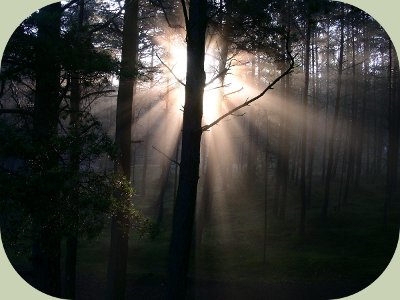

About the Author: Filip Tkaczyk is a periodic guest teacher at Alderleaf. He also wrote the field guide Tracks & Sign of Reptiles & Amphibians. Learn more about Filip Tkaczyk.
Return from Tree Identification Article to Plants Articles
Is The Essential Wilderness Survival Skills Course Right for You? Take the "Online Survival Training Readiness" Quiz
See for yourself if this eye-opening course is a good fit for you. It takes just a few minutes! Get your Survival Training Readiness Score Now!

Grow Your Outdoor Skills! Get monthly updates on new wilderness skills, upcoming courses, and special opportunities. Join the free Alderleaf eNews and as a welcome gift you'll get a copy of our Mini Survival Guide.

 The Six Keys to Survival: Get a free copy of our survival mini-guide and monthly tips!
The Six Keys to Survival: Get a free copy of our survival mini-guide and monthly tips!
Learn more